There are so many things I admire about talented Hélène Magnusson, but perhaps most particularly her completely joined-up approach to sheep, wool, yarn production, textile history, and contemporary knitwear design. All these elements are to the fore in the very special hap Hélène has created for our collection, a Hapisk – whose name as well as its very stitches mingles Iceland and Shetland together. Because we share so many passions Hélène and I always have a lot to say to one another – but I think you’ll find our conversation interesting!
KD Hi Hélène! I’m so happy you were able to be a part of this project. We love your Hapisk design – a mash-up of Shetland and Icelandic textile traditions – and were interested to hear more about the Icelandic long shawl which partly inspired it. Can you tell us more about the history and construction of this textile?
Hi Kate! I’m very hap-py as well to be part of this beautiful project together with so many talented designers whose work I’ve long admired. You and Jen have created such an amazing collection! There are two types of everyday shawls in Iceland, the equivalent of the Shetland hap. In the past, triangular shawls (knitted in garter stitch from the top down) were the most common. These shawls often had stripes, sometimes a few eyelet rows to decorate, or just a simple lace border. Women would wear one or more shawls on top of each other in this manner, over their (knitted) jacket: they didn’t have any sweaters so the shawls were their sweaters and they would wear them with long wrist warmers as sleeves.
The long shawls probably came to Iceland as a fad and were very common in the 1920’s. They included long lace stoles, and plainer garter stitch long shawls. The everyday ones were those knitted in garter stitch and often busily striped. Knitters used all kind of yarns and any left overs to make them. I find the busy-ness in the stripes very reminiscent of the stripe sequences you see in other Icelandic textiles, such as shoe-inserts or woven blankets. These shawls would be worn around the shoulders with the two long lengths hanging freely at the front. If wrapped around the body, such shawls were also big enough to cover the back and the entire chest, and were often fastened with a belt in such a manner.
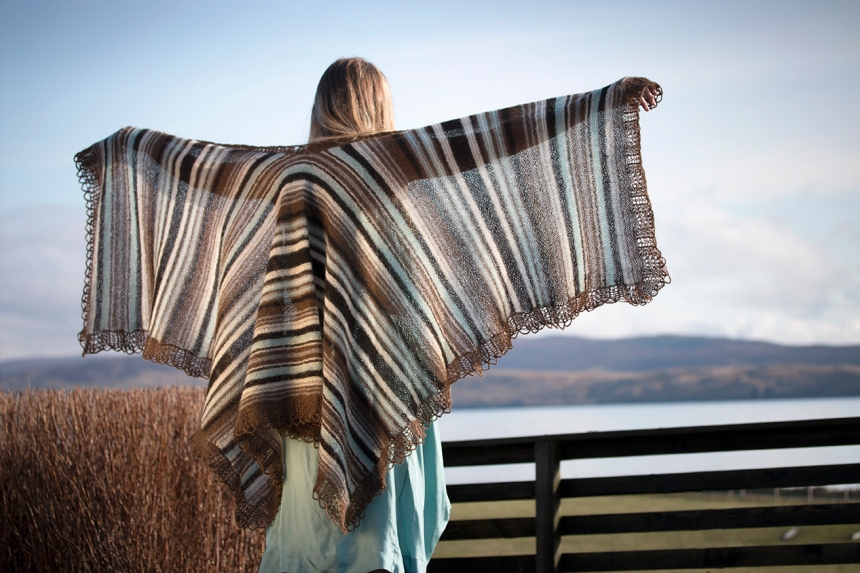
KD This is so fascinating to me, Hélène. In the Book of Haps I discuss an interesting photograph of a famous Shetland author wrapped in a really gigantic hap that is striped all over. The picture dates from 1926 – such large hand-knitted wraps were clearly popular in Shetland as well as Iceland at around this time!
HM yes, and just like Shetland haps and shawls, in Iceland such textiles were knitted in many ‘grades’ of fineness. In Iceland there were also Sunday-best lace triangular and long shawls, worked with very fine handspun yarns (often made from the thel, the very soft, fine and warm inner layer of the Icelandic sheep), in an array of delicate colours. The fancier triangular shawls usually had a rather simple lace motif in the triangle and a very lacy border with color stripes scaling from light to dark in natural sheep colours or plant dyed colours. The border was finished with a crochet bind-off making characteristics crocheted arches at the edge. The long lace stoles were knitted in an array of refined plant-dyed colourrs and natural sheep colours, undulating motifs and more intricate lace motifs. Many had a fringe. There are also examples of long shawls made from hanspun tog yarn (the tog is the coarser outer hair). These shawls are very special: they are very crispy with a weight to them but nevertheless amazingly warm and light.
KD I discuss “fancy” Shetland haps in the book as well – ones which like the Icelandic triangular “best” shawls had a patterned centre. There are so many interesting similarities between knitting practices in the two locations, but one difference that really fascinates me is that Shetland lace patterns are routinely worked over a background of garter stitch whereas Icelandic lace is worked over a background of stocking stitch, using much the same (or very similar) stitch patterns. I wondered if you had any thoughts about this intriguing difference?
Well, I’d first like to mention an important difference between Shetland fine lace and Icelandic fine lace. Whereas Shetland fine lace was an exclusive product, destined for sale to wealthy folk, and even worn by the British royal family, Icelandic fine lace stayed largely inside Icelandic homes. Also it was never “officially” part of the Icelandic national costume, the women tended to wear these beautiful shawls on Sundays and other festive occasions with their costume. The shawls became a way to show off how skilled they were at working the wool, spinning it, dyeing it and knitting it.
As regards stocking stitch, its interesting that in the first printed needlework book published in Iceland in 1886, Leiðarvísir til að nema ýmsar kvennlegar hannyrðir (which translates as “Instructions for the study of various feminine handicrafts”), a few lace motifs are depicted including the spider pattern recurrent in so many Icelandic shawls. This was a really fashionable and frequently worked motif, and was worked on a background of stockinette. We do find lace motifs worked over a background of garter stitch in Icelandic triangular shawls, but stocking stitch is much more common. My feeling is that Icelandic knitters enjoyed this particular “look” in lace. Perhaps too, because stocking stitch used less yarn than garter stitch, it was a good canvas for displaying small amounts of colour.
KD yes, small amounts of colour must have been highly prized in Iceland just as they were in Shetland, where tiny amounts of specific shades might be spun up from differently coloured sheep, and carefully brought together in the borders of a hap
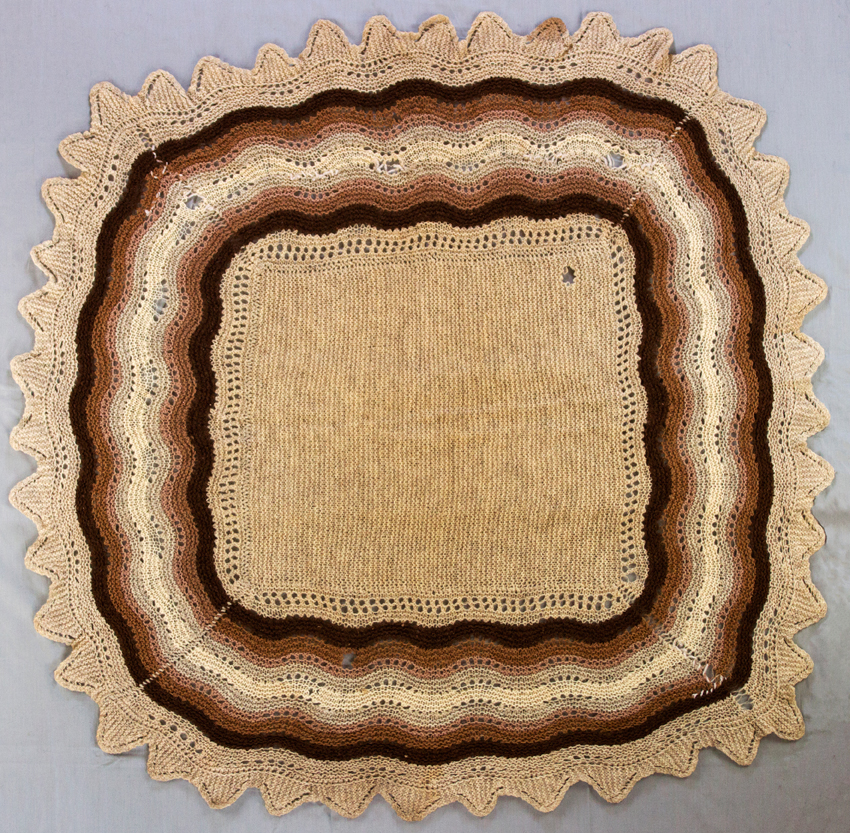
(worn and darned Shetland “lasses” hap from the Shetland Museum and Archives, showing the judicious use of handspun natural shades in the border).
HM – exactly – in Iceland these shawls were made out of handspun thel yarn, which demands a great amount of time (separating the tog from the thel being in itself a very time consuming task which even today cannot be achieved by machine). Colours might be separated into tiny amounts, grading the natural shades from the darkest to the lightest, or dyeing and grading stripes similarly.
KD We are lucky that so many of these different shawls have now been collected and preserved for us to learn about! The Shetland Museum and Archives has many wonderful examples of haps and shawls, and its because of this great resource that I’ve been able to understand more about them, and the different contexts of their making. The Icelandic museums play a similar role for you, I imagine.
HM absolutely, and it is thanks to Halldóra Bjarnadóttir (1873-1981) that we can admire so many beautiful items today at the Icelandic Textile Museum. Halldóra was an energetic and remarkable woman, with a great interest in all different types of Icelandic shawls. She travelled around Iceland with a golden ring, which she used to select the finest, most ethereal shawls that could be drawn effortlessly through it. Halldóra organised many competitions and craft exhibitions and wrote the craft magazine Hlín: her whole purpose was to bring the beautiful things that were being created by ordinary women in their homes to light, and to show them to the world.
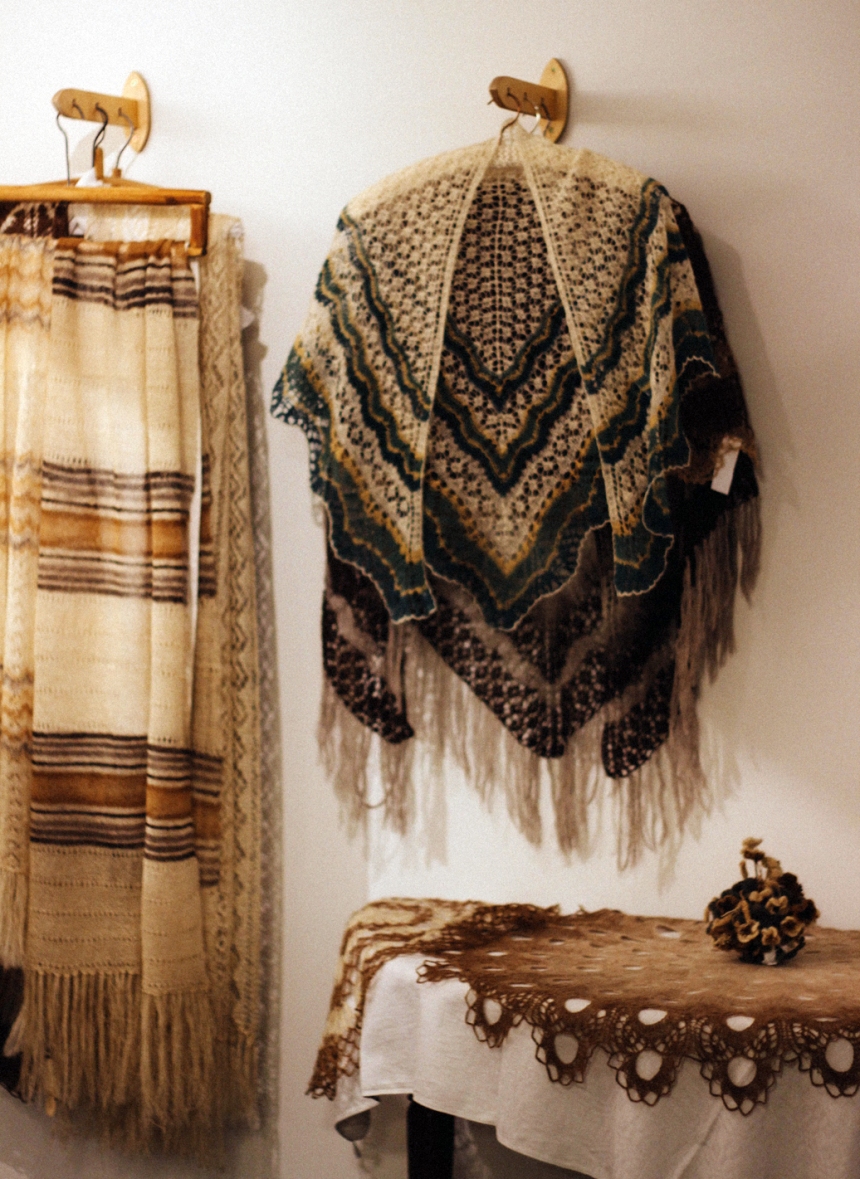
(part of Halldóra Bjarnadóttir’s collection at the Iceland Textile Museum. Image courtesy of Ella Gordon)
KD I’m interested in the process of designing your Hapisk. What was your starting point? And did the process bring any surprises?
HM When you asked me to be part of the book, I figured you probably expected from me an Icelandic version of a Shetland hap. So right away, I looked at the main characteristics of Shetland haps and set myself boundaries: it had be a big square shawl with a garter stitch center, a shell pattern and a lace border. I also decided right away my hap would be divided in the middle to make the square shape wearable in a more modern way: perhaps more like a cape, a poncho or a wrap that is thrown around one shoulder. Then I had to incorporate Icelandic elements that would remind knitters of both traditions, and decided to have a better look at the striped long shawls. (Previously I had only come across photographies and seen one shawl from a private owner but I wanted to examine them more closely).
Since everybody in Iceland seemed to know about them, I was in no doubt I would find enough material to work from in the Icelandic museums. I never really expected to find many of them, but how very surprised I was, after queries in different museums around the country, to find… none. In the archives of the National Museum of Iceland, I could only find one striped long shawl (dating 1910-1915) but with a few unusual longitudinal stripes, and knitted quite loose. The Textile Museum in Blönduos has many long shawls but of a very refined nature, knitted with very fine handpun thel. One explanation for the absence of simpler long shawls maybe that many of the items in the Museum come from Halldóra Bjarnadóttir who I mentioned earlier, best known for her pioneering work in the education and culture of women and the promotion of the textile industry in the last century. Halldóra actually detested the long striped shawls and strongly discouraged them in any competition or craft exhibition she organized.
KD this is very interesting. I wonder if she felt they were too ordinary and everyday to be of interest? Ordinary working garments are sadly far less frequently preserved in museum collections, both because they are worn, and wear out, but also because they might be deemed less worthy of interest.
HM yes. The fact that this wonderful everyday Icelandic textile now seemed so rare made me even more keen to honour it in my hap design (with all due respect to Halldóra, whose work was so important).
The garter stitch centre, sequence of stripes, and the size and shape of my Hapisk recall the traditional Icelandic long shawl. The lace shell border is worked over stocking stitch, and concludes with crocheted arches. You encouraged me to use my own soft Icelandic yarns, made of pure Icelandic lambswool that I select especially by hand for quality and softness. I chose my Gilitrutt yarn for this design: because it is plied, it is a strong lace yarn but still has all of the lightness and warmth expected from the unspun Icelandic lopi wool with a surprisingly soft hand and halo. For the colours, I decided to stick to the natural sheep shades, in which Icelandic long shawls would have been originally knitted, and which are quite close to Shetland colours (indeed the Icelandic and Shetland words for different shades have obvious linguistic similarities, for example: moorit / mórautt).
Adding pale blue in place of white, is my own personal modern touch of color. This blue/green shade, called Askja Blue in my Gilitrutt range, is present in Icelandic nature, and I named the shade after the Viti (volvanic crater) lake in the Askja Caldera in north Iceland. It is a a similar color to the famous Blue Lagoon.
KD You have created some really beautiful shawls – such as Randalin, Hila and the Icelandic Spring Shawl, all of which mingle ‘traditional’ Icelandic elements with contemporary techniques and styling (and which look particularly beautiful in your Love Story yarn). I wondered if you might reflect generally on how Icelandic textile history and traditions of making inspire your modern design practice?
Thank you Kate!
I’m fascinated by old things, especially the daily objects, and the story they tell. I like to touch them, turn them all around, examine them closely, sometimes with a magnifying glass. I think my designs work in the same manner, turning things upside down, magnifying details, making large elements small and small things big. I find it incredible sometimes that making minute alterations can have such a dramatic effect on a design. I usually start by looking then researching: I like to know how things were done, what they mean and I wouldn’t want to ever be disrespectful to a tradition or making practice by interpreting wrongly or distorting a cultural element. This doesn’t mean that I always stick to the way things were always done: on the contrary, I do believe we show most respect to traditions by continuing them in different contexts, thus giving them new life.
KD I completely agree! And your work perfectly balances the old and the new.
HM To achieve that balance, I like to set to myself strict boundaries. It may limit the design possibilities but I also find it intellectually quite enjoyable, forcing myself to find solutions, do a bit of engeneering so that at the end it fits into the particular logic I have set beforehand. My Icelandic Spring shawl for example has all the elements of a traditional triangular shawl: a triangular shape, the recurrent spider lace pattern in the body, a colorful lace border with undulating motifs, a crocheted bind-off. What makes it different and modern is the size and the accentuated triangular, the triangle is rather small but with very long curvy wings like a boomerang and rolls naturally around the neck. It’s meant to be worn more like a big handkerchief with the main body hanging at the front or on the side around one shoulder. Another element of modernity is achieved by simply making regular color stripes in the lace border, rather than the more traditional graded shadings. The Hila shawl is completely traditional: only the Askja blue color, again, makes it stand out and gives it a modern feel.
KD I know you enjoyed visiting Shetland for Wool Week last year. Shetland is, like Iceland, an island culture in which both sheep and knitting flourish. Did you feel at home there? And I wondered if you perceived any other similarities (or differences) between Shetland and Iceland?
Yes I felt quite at ease in Shetland and the language not being an obstacle, it was really easy to talk to the local people. But I wouldn’t want to bore your readers with a very long comparative essay between Iceland and Shetland! So I will just stick to what struck me the most, that is the diversity found there in the wool industry compared to Iceland (I’m not including the handspun yarns).
Just as in Iceland where Istex is our one and only spinning mill, you have today a single mill in Shetland, situated in Sandness. Nevertheless, you have so many more different types of yarn and producers than we have. You also offer such a great range of undyed yarns in natural sheep colors, whereas the numerous natural colors from Istex are made by carding together dyed wool. And all that despite the fact that you have far less sheep than we have on the island and no less natural colors than the Shetland breed.
The reason for that is not a lack of creativity or will in Iceland, it’s probably the geographical context: it seems so easy for Shetlanders to send wool out of the islands. This is exacly what Jamieson & Smith, one of your biggest producer of yarn, is doing after having carefully sorted the wool by hand locally. So does Shetland Organics, a Community interest company for collaborating farmers that make certified organic wool from sheep born and bred in Shetland. Then you have all sorts of very small productions, making really special yarns such as the Fair isle Home grown Wirsit from Kathy Coull, the Uradale yarns or the Foula wool. All those smaller productions are spun in the mainland in mills that take small quantities at the time – the minimum being only 20 kilos.
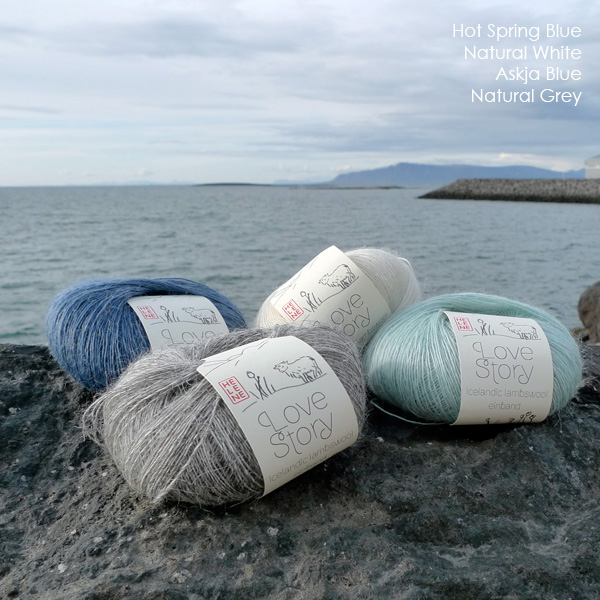
(Hélène’s beautiful hand-sorted Love Story yarn)
KD yes, I can tell you from my own experience that it is still costly and tricky for small producers to create yarn from local sheep, but here in the UK we do still have the infrastructure of scouring and spinning that I know creates additional impediments for producers in other countries.
HM well, I can definitely confirm that it’s a big deal to send wool to the continent from Iceland to be processed: it costs a lot of money especially for small quantities (I send at least a ton which fits a container, making it much more economically viable. Then there are also LOTS of paperwork and bureaucratic hurdles to be overcome: Iceland is not part of Europe and despise all the campaigns for wool, unwashed wool is still considered as an animal by-product and goes by the same rules of hygiene that govern animal carcasses. So, the only yarns we have in Iceland are those produced by Istex: the lopi yarns from Istex themselves, and then two other types of yarns they are making for other designers: Einrúm by Kirstin Brynja and Mosi by Gusta. Einrúm is Léttlopi or Istex Einband spun together with thai silk; and Mosi with Alpaca (it actually comprises only 30% Icelandic wool). And then…you have me! I hand select the softest Icelandic lambswool, and send it to Italy where it is spun and dyed, then sent back to me. We do have a few yarns spun in mini-mills abroad; but it’s so little, just a couple of kilos, that you can’t really talk about a production, those are rather trials. It’s how I indeed started. It’s silly but I had not really realized before what I had achieved. I was shocked. Proud. Humbled. And then really frightened! What a responsibility! Many people show a great interest in starting a little mill in Iceland, or even 30 of them. I hope this dream will one day become reality!
KD Hélène your wonderful yarns are an amazing achievement! The knitting world is all the richer for your existence. Thanks so much for everything you do, and especially for contributing your beautiful Hapisk to our collection.
HM Thankyou, Kate and Jen, for inviting me to contribute!
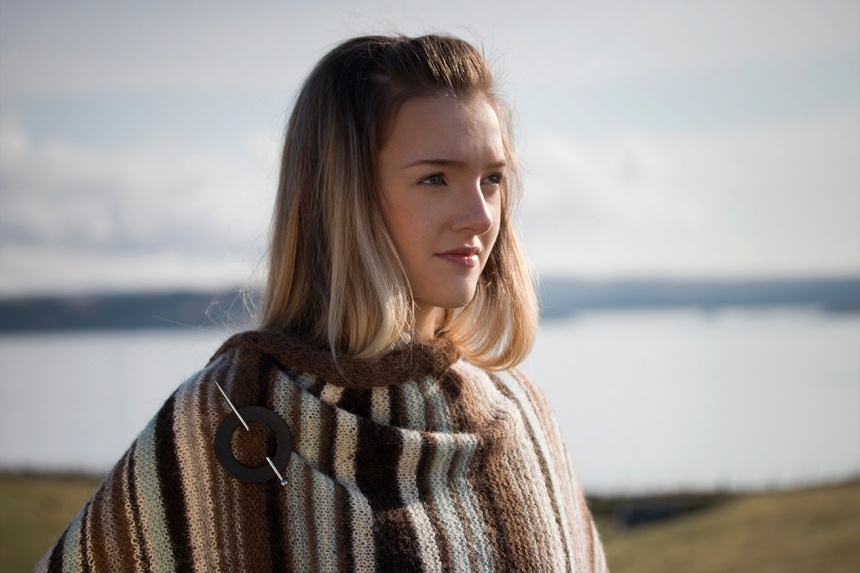
Hélène has now created a yarn-kit for her Hapisk design! .
You can follow the haps as they are revealed each day on Ravelry, and pre-order the book here. Tomorrow is the last design reveal! Pop back here to see the final hap!


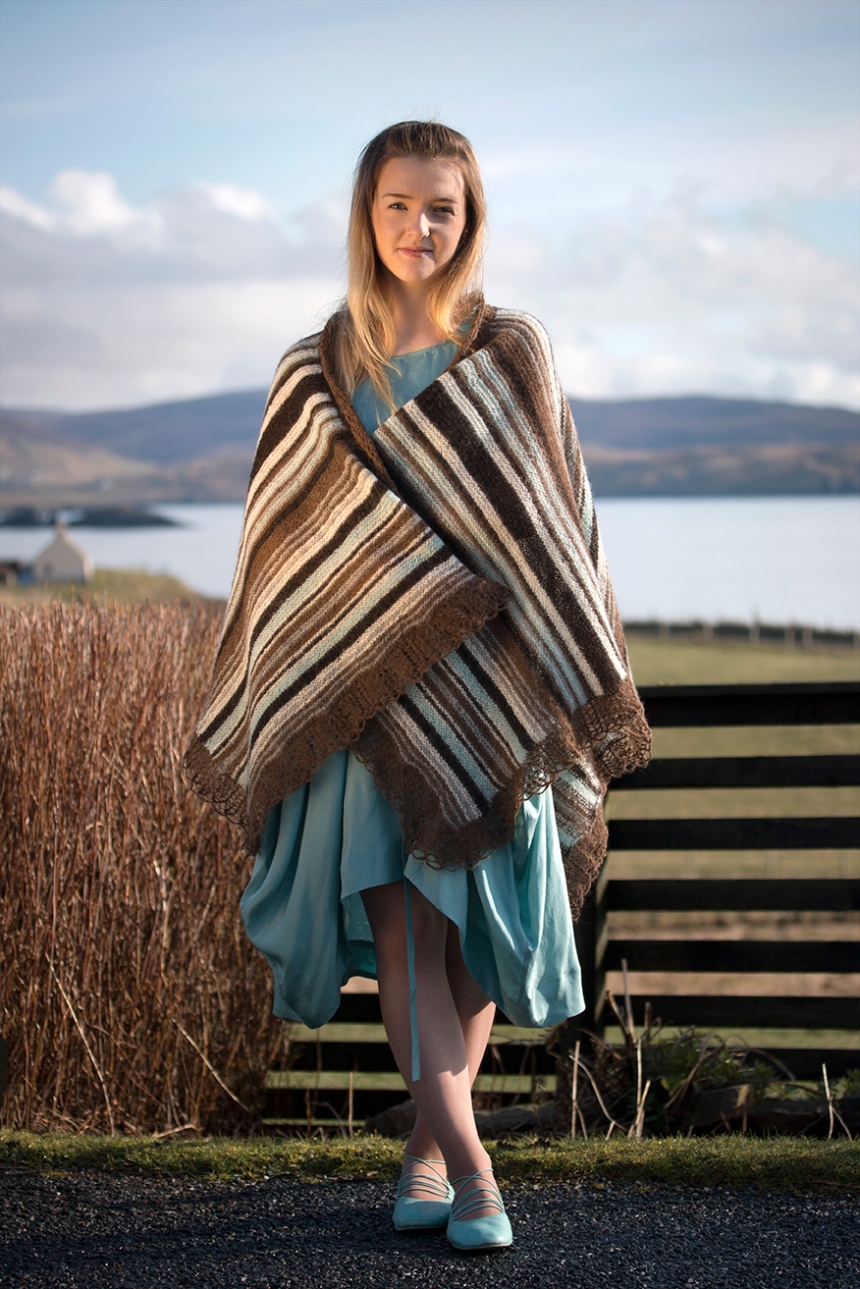


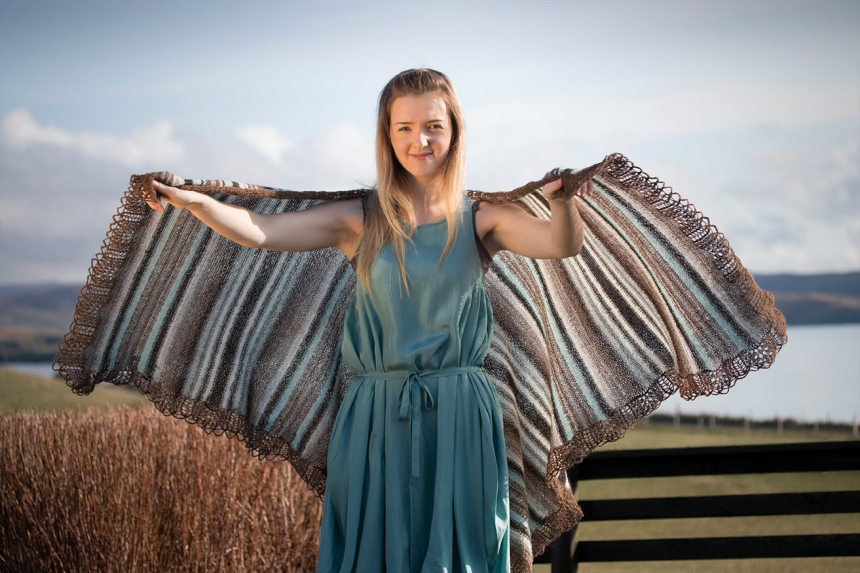
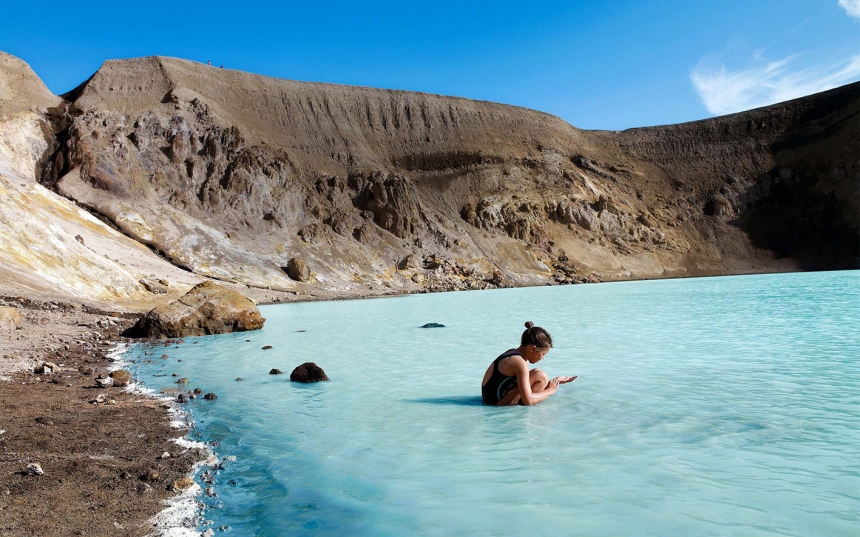
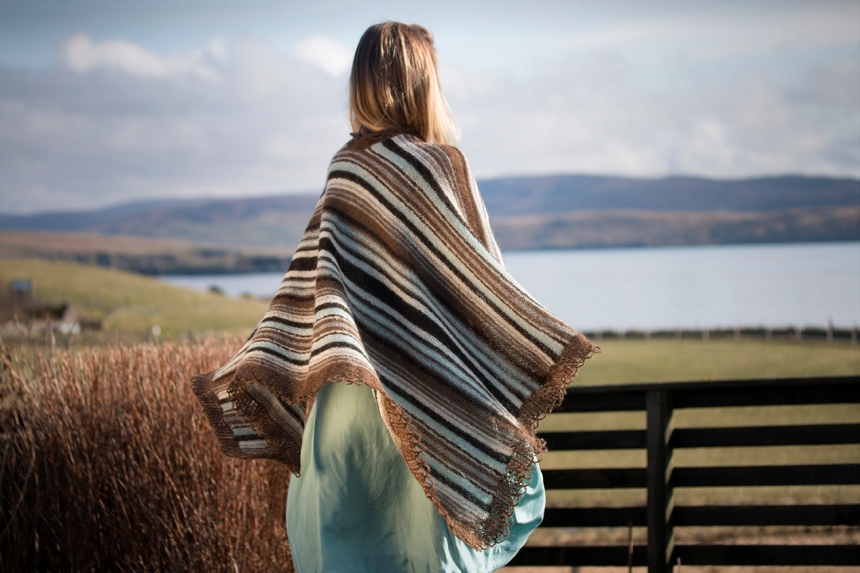

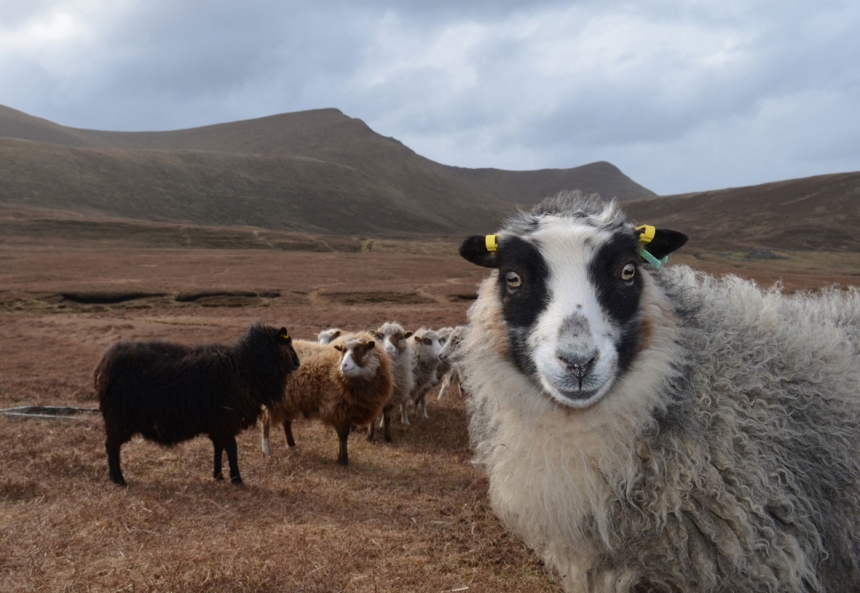
KDD & CO.infact, seeing your beautiful and cherished designing as regards to series of ornaments and textile designs, I feels so much satisfied as if, I wear it in my hand and body.it is a nice idea and initiative.more power to elbow.
LikeLiked by 1 person
The Hapisk shawl is very much
the same shape as the scottish
Ruana?
LikeLike
As they say, timing is everything! I leave next week for Iceland and I’m very excited to get my hands on some beautiful Icelandic yarns. I look forward to receiving my book and casting on. Thanks for all the information and the beautiful designs.
LikeLike
I’m loving this one – I came very close to buying a poncho this last winter and this has made me realise that I should just knit one instead. Such a very practical and wearable shape!
LikeLike
The colours of this hap have inspired me today and confirmed to me my musings on colours. The interviews have been remarkable, I am grateful for each one and respect each designer with their contribution to the book I cannot wait to receive
LikeLike
What a stunning approach to a hap that combines elements of both Shetland and Icelandic design. And I greatly appreciate the discussion and emphasis on the everyday rather than the fancy in both regions. Helene, this will be a beautiful, airy knit in your gorgeous yarn, while also being warm and cozy. Thank you both for making history come alive through thoughtful design. Fabulous book, Kate!
LikeLike
Thank you, this is so interesting and I love her colours!
Sent from my iPad
>
LikeLike
Every design has me gasping with awe at the ingenuity of the designers. And tomorrow is the last day of the reveals! I’m going to miss this daily feast for the eyes. Your teasing allusions to some of the pieces you’ve written for the book have me desperate to hold, read and use this book. I cannot wait!
LikeLike
The way the colors echo Iceland is beautiful. I especially love the Askja blue.
LikeLiked by 1 person
Just before I read this post I was tau arises to read this: http://icelandmag.visir.is/article/iceland-facing-a-knitting-wool-shortage-due-tourist-boom
A very beautiful hsp, Helene.
LikeLiked by 1 person
The shape of the Hapsik immediately reminded me of the Ruana as featured in Cheryl Oberle’s book Folk Shawls. The difference is that this one is knit lengthwise an the ruana is knit side to side.
LikeLiked by 1 person
A very interesting and educational interview. The patterns are all so beautiful!
LikeLiked by 1 person
Yet again another terrific discussion and explanation of how the designer works through the process to the end object. Just loving these introductions to your book.
LikeLiked by 1 person
How fascinating to hear how Hélène designed this beautiful hap. I am entranced with how the browns and the pale blue she used mirror the colors in the photograph of the Askja Caldera. And what breathtaking styling and photography of the hap!!
LikeLiked by 1 person
Agreed!
LikeLiked by 1 person
I’ve really enjoyed not just seeing all these beautiful hap designs but reading about the designers inspirations and considerations in creating their haps…..I think this was my favourite Kate/designer chat so far.
LikeLiked by 1 person
Such an interesting discussion. I’ve learnt so much. What an inspiration. Thank you
LikeLike
so so impressed.
all the pattern are gorgeous.
:-)
LikeLiked by 1 person